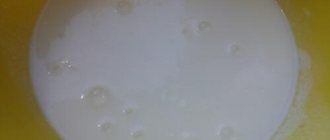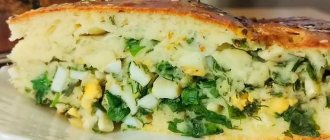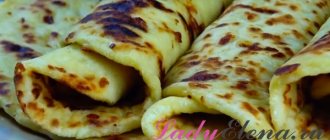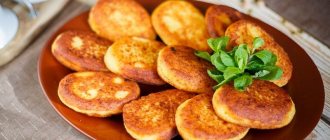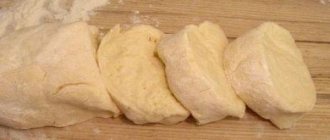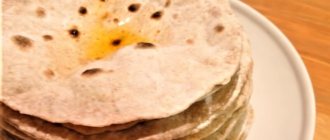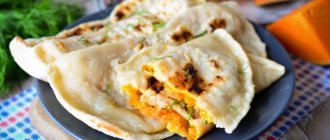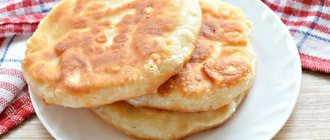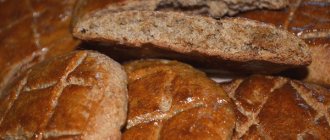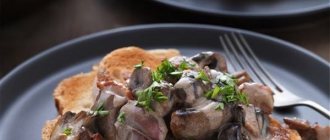Share
Vainakh flatbreads are prepared using the same technology, regardless of whether they are filled or not. Flatbreads have different names due to the composition of the fillings: cottage cheese, pumpkin, potatoes. Chiepalgash is formed of the same size and shape - round. The thinner a woman can make a filled flatbread, the more her culinary skills are valued. The pinnacle of culinary skill in making chepalgash stuffed with cottage cheese or potatoes is the thinnest, most tender flatbread with evenly distributed filling. In Chechnya they say about such flatbreads: “Parduo sanna, dutka dina ch1epalgash.” Which means “the cakes are made thin, like chaff.”
Rituals and traditions
One of the wedding rituals associated with baking is very interesting. The ritual of including the newlywed into the economic life of the family is usually accompanied by music, songs, and shooting. Three days after the wedding, the bride was led to water - a spring, a river. Cake cakes were baked especially for the ceremony, and a needle taken from the hem of a wedding dress was stuck into one of them. Chepalgash with a needle was thrown into the water and shot at it to drive away hostile spirits from the bride. After this, the bride collected water and returned home.
How to cook “Chepalgash”
First, prepare the dough by mixing warm kefir with salt, sugar, soda and flour. Next, mix the cottage cheese with the egg, add a little salt - this is our filling. Divide the dough into 8 equal parts, put the prepared filling in the middle of each part and connect the edges so that the filling is inside.
Now roll out the dough with the filling inside into a fairly thin cake.
Heat the frying pan well and place the flatbread on it. No need to add oil.
Fry on both sides until brown spots form.
Remove the pancake from the pan and quickly dip it in boiled water, rinse it off from burning.
Place the flatbread in a saucepan, grease thoroughly with butter and cover with a lid. We do the same with all the flatbreads.
Then put it on a wide dish and cut it into 8 pieces like a cake. Bon appetit everyone!
Chechen fairy tales
Chepalgash miraculously reconciles the inhabitants of the copper jug in the Chechen folk tale “The Jug-Tower”. The fairy tale is similar to the Russian folk tale “Teremok”, only the fox plays the role of a negative character, and the teremok is a copper jug in which chepalgash, skillfully prepared by a frog, a hedgehog, an ant, a lizard and a squirrel live and eat. I won’t retell you the whole fairy tale and the decisive battle with the cunning fox; I like the ending better:
At this time the frog came out: “Why were you so late?” Chepalgash has been ready for a long time. Come in, we’ll have dinner,” she called everyone. They washed their hands and faces and sat down to eat chepalgash and drink tea. They invited me too, and I ate chepalgash and drank tea with them. And now an ant, a lizard, a frog, a hedgehog and a squirrel live in friendship and harmony in their pitcher-tower.
KIudal-bIov (Jug-tower). Chechen folk tale
Here is a recipe for flatbreads with cottage cheese with photos and correct proportions. Shall we bake Vainakh flatbreads (ch1epalgash) chepalgash with cottage cheese and herbs (green onions)? I'm sure you will succeed. Check out my other recipes for Chechen cuisine, for example, dalnash with tripe.
Chepalgash flatbread with cottage cheese and herbs - a traditional national dish of the Chechens
Chepalgash is a national Chechen flatbread with filling.
At the same time, the filling can be very varied - pumpkin, cabbage, mashed potatoes. But perhaps the most popular flatbreads are chepalgash with cottage cheese, surprisingly tender and soft! These flatbreads are prepared quite quickly and simply, so preparing them is not difficult. The flatbreads turn out deliciously tasty and very filling. After trying chepalgash just once, you will definitely want more!
Khingalsh with pumpkin
How to form a chepalgash flatbread
After the dough has rested sufficiently and the filling is prepared, you can begin rolling out the cake. To do this, cut (or tear off) a piece weighing no more than 250 g from the total volume of dough. Experienced chefs recommend forming three flat cakes at a time, since they fry very quickly.
From each piece of dough you need to form an elastic ball. It can be sprinkled with flour if necessary so that when rolling the cake does not stick to the table. The dough ball is gradually stretched by hand until it is approximately 10 mm thick. Then place the prepared cake on the table and continue rolling it out with a rolling pin (up to 3-5 mm). Aim for the edges of the circle to be thinner than its middle.
Cold filling is placed on each rolled out flatbread. It should be the same volume as the dough. The same ball is formed from it, which is then placed in the center of the cake. Next you need to mold (connect) the edges of the dough so that the filling is completely covered. To do this, use the method from edge to center.
To roll out the flatbread, place it seam side down on a floured table. Its finished thickness should be no more than 4 mm. Roll out the cake mainly in the center, constantly turning over and rotating in different directions. Be careful that the edges do not become too thin.
When three flatbreads are rolled out, you can start frying chepalgash with potatoes, the recipe for which is presented below, or with other ingredients. You need to heat up the frying pan. Fry the flatbreads on both sides until golden brown. Then wipe the chepalgash with a dry towel to remove excess flour, dip it alternately in boiling water or sprinkle with hot water. Place the finished flatbreads in a stack on a plate, brushing them with butter.
Let's start preparing the filling.
Ingredients for chepalgash filling:
- Country cottage cheese (fat) – 200 g;
- Onion feathers – 4-6 pcs.;
- Dill – 2-3 sprigs;
- Parsley – 2-3 sprigs;
- Salt – 0.5 teaspoon.
Additionally:
- Butter (for greasing) – 50 g.
Honey cake
Preparation of dough for chepalgash
According to the traditional recipe, chepalgash is prepared from unleavened dough. For it you will need kefir and flour, taken in a 1:1 ratio, as well as a teaspoon of salt and soda.
- Sift flour (600 g) into a deep bowl, add salt and soda, mix with your hands and pour in 600 ml of kefir (can be replaced with homemade yogurt).
- Knead the dough thoroughly, adding flour if necessary (an additional 50 g may be needed). The result should be a soft and elastic dough that sticks a little to your hands (you will need to add more flour when rolling).
- Cover the bowl with the kneaded dough with a lid or towel and leave on the table to “rest” for 15-20 minutes.
- After the specified time, knead the dough again on the table, adding flour if necessary (about another 70 g). Here it is important not to overdo it, otherwise the cakes will turn out too hard and it will be very difficult to roll them out. Transfer the dough to a bowl and leave under a towel for another 15 minutes.
- After the dough has “rested,” the swollen gluten makes it homogeneous and maximally elastic, stretches very well, which means the chepalgash, the culinary recipe for which is presented here, will not tear when rolled out.
Benefits of Chepagash
Chechen chepagash is a filling and high-calorie dish, but very healthy, since it undergoes minimal heat treatment and the food in it practically remains fresh. This means that cottage cheese, having calcium, phosphorus, iron, magnesium, vitamins A, B, D, retains them in the finished dish. In addition to all the beneficial qualities, cottage cheese is easily digestible and contains almost no milk sugar.
If you decide to cook chepalgash with pumpkin or potatoes, the usefulness of these products will also not be impaired; all valuable vitamins will remain in the finished dish. And in order to fully enjoy the taste of the dish of the peoples of the North Caucasus, the finished chepalgash should be served with hot sweet tea with milk.
Recipe for Chechen chepalgash made from corn flour
The classic recipe for making Chechen flatbreads uses corn flour rather than wheat, which is considered healthier. But such chepalgash have a specific taste that not everyone likes. Therefore, in the modern interpretation, the recipe for chepalgash with corn flour is used occasionally.
However, those who want to taste the flatbread prepared according to the old version need to know that the proportions for the dough remain the same.
Vainakh flatbreads made from wheat flour - tender, thin, aromatic
Vainakh flatbreads made from wheat flour - tender, thin, aromatic
It is assumed that pumpkin (g1abakh) appeared among the Vainakhs long before the Caucasian War. In the plateau of Chechnya, pumpkin began to be grown in the 19th century. The Vainakhs quickly became famous as masters of abundant melon and melon harvests far beyond the borders of their region. There was no area or household where a pumpkin did not grow near the fence. Pot-bellied beauties planted their tops on fences and grew in plots wherever there was at least some free space - in ravines, holes, among other vegetable plantings. Gradually, varietal specimens began to appear, differing in sweetness, color, shape, and fodder specimens, used for fattening small and large horned livestock. What did the Vainakhs cook from pumpkin?
Chepalgash with potatoes
For the potato filling you will need approximately 800 g of potatoes, boiled in their skins. This is the recommended method of preparing it, since this way the filling will be drier, which means that the cake will be easier to roll out and will not become soggy or tear.
Boiled potatoes need to be peeled, mashed well, add salt, pepper and other spices to taste. You can additionally fry finely chopped onion. This will be a recipe for chepalgash with potatoes and onions. After the filling has cooled, you can form the cake.
Types of filling for Chechen chepalgash
The whole taste of chepalgash flatbreads lies in the filling, although sometimes they are prepared without it, just like thin pancakes. They also turn out quite tasty.
Traditionally, chepalgash is prepared with cottage cheese. But other types of filling can be used:
In general, the filling for chepalgash is the basis for experimentation. Flatbreads cooked with herbs, wild garlic and other ingredients will be no less tasty.
Related materials:
Recipe | Recipes | Chepalgash | ingredients | potatoes | quick breakfast | Vainakh cuisine | A true legend | national cuisine | National dish | National dishes | taste | water | option | appetite | breakfast | quickly | delicious | Caucasus
Articles
- Dessert. Bulk apples August 27, 2011, 14:00
- Panna Cotta 24 August 2012, 14:00
- Puffed casserole September 13, 2012, 14:00
Video
- Home SPA: SHISEIDO massage mask November 18, 2009, 00:00
- Lip makeup options from Dior March 18, 2010, 00:00
- Idylle by Guerlain. History of creation October 25, 2011, 11:03
Chepalgash: cooking secrets
Like any dish of national cuisine, chepalgash also has its own cooking characteristics:
- Fry the flatbreads only in a hot dry frying pan. The finished chepalgash is transferred to a plate, after which it is generously greased with melted butter.
- The unique technology for preparing chepalgash is that the finished flatbread must be immersed in clean boiling water for a few seconds. In this way, flour and soot are washed off from the surface of the cake, and it itself becomes unusually soft and tender. Only experienced housewives can cope with such a “ritual”, therefore, to simplify the task, many simply sprinkle the chepalgash with hot water.
- Chepalgash is always stacked, then the flatbreads are well soaked in melted butter on both sides. Once the stack is high enough, it is cut from top to bottom into 5-6 pieces.
- Chepalgash, the recipe for which is passed down from generation to generation in every family, is made exclusively in a round shape and rolled out as thinly as possible.
- Chechen flatbreads are served with hot tea or milk drinks.
